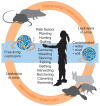New hypothesis for cause of epidemic among native Americans, New England, 1616-1619
- PMID: 20113559
- PMCID: PMC2957993
- DOI: 10.3201/eid1602.090276
New hypothesis for cause of epidemic among native Americans, New England, 1616-1619
Abstract
In the years before English settlers established the Plymouth colony (1616-1619), most Native Americans living on the southeastern coast of present-day Massachusetts died from a mysterious disease. Classic explanations have included yellow fever, smallpox, and plague. Chickenpox and trichinosis are among more recent proposals. We suggest an additional candidate: leptospirosis complicated by Weil syndrome. Rodent reservoirs from European ships infected indigenous reservoirs and contaminated land and fresh water. Local ecology and high-risk quotidian practices of the native population favored exposure and were not shared by Europeans. Reduction of the population may have been incremental, episodic, and continuous; local customs continuously exposed this population to hyperendemic leptospiral infection over months or years, and only a fraction survived. Previous proposals do not adequately account for signature signs (epistaxis, jaundice) and do not consider customs that may have been instrumental to the near annihilation of Native Americans, which facilitated successful colonization of the Massachusetts Bay area.
Figures



Similar articles
-
The significance of disease in the extinction of the New England Indians.Hum Biol. 1973 Sep;45(3):485-508. Hum Biol. 1973. PMID: 4584337 No abstract available.
-
Smallpox and American Indians revisited.J Hist Med Allied Sci. 2010 Oct;65(4):445-77. doi: 10.1093/jhmas/jrq005. Epub 2010 Mar 9. J Hist Med Allied Sci. 2010. PMID: 20219730
-
Smallpox and the Native American.Am J Med Sci. 2002 Apr;323(4):216-22. doi: 10.1097/00000441-200204000-00009. Am J Med Sci. 2002. PMID: 12003378 Review.
-
The role of epidemic infectious diseases in the discovery of America.Allergy Proc. 1992 Sep-Oct;13(5):225-32. doi: 10.2500/108854192778817040. Allergy Proc. 1992. PMID: 1483570
-
Review paper: Host-pathogen interactions in the kidney during chronic leptospirosis.Vet Pathol. 2009 Sep;46(5):792-9. doi: 10.1354/vp.08-VP-0265-N-REV. Epub 2009 May 9. Vet Pathol. 2009. PMID: 19429975 Review.
Cited by
-
GDP effects of pandemics: a historical perspective.Empir Econ. 2022;63(6):2949-2995. doi: 10.1007/s00181-022-02227-3. Epub 2022 Apr 7. Empir Econ. 2022. PMID: 35411126 Free PMC article.
-
A call to order at the spirochaetal host-pathogen interface.Mol Microbiol. 2013 Jul;89(2):207-11. doi: 10.1111/mmi.12286. Epub 2013 Jun 19. Mol Microbiol. 2013. PMID: 23750784 Free PMC article.
-
Recent leptospirosis outbreak: an urgent warning around the globe, genomic features, diagnosis, and treatment procedures-correspondence.Int J Surg. 2023 Mar 1;109(3):622-623. doi: 10.1097/JS9.0000000000000221. Int J Surg. 2023. PMID: 36906746 Free PMC article. No abstract available.
-
Leptospirosis in French Historical Medical Literature: Weil's Disease or Kelsch's Disease?Am J Trop Med Hyg. 2018 Dec;99(6):1366-1368. doi: 10.4269/ajtmh.18-0629. Am J Trop Med Hyg. 2018. PMID: 30298813 Free PMC article.
-
Historical Spatial Distribution of Zoonotic Diseases in Domestic, Synanthropic, and Wild Animals in the Mexican Territory of the Yucatan Peninsula.J Trop Med. 2021 Aug 7;2021:8699455. doi: 10.1155/2021/8699455. eCollection 2021. J Trop Med. 2021. PMID: 34413891 Free PMC article.
References
-
- Cook SF. The significance of disease in the extinction of the New England Indians. Hum Biol. 1973;45:485–508. - PubMed
-
- Webster N. A brief history of epidemic and pestilential diseases. Hartford (CT): Hudson and Goodwin; 1799.
-
- Williams H. The epidemic of the Indians of New England, 1616–1620, with remarks on Native American infections. Johns Hopkins Hospital Bulletin. 1909;20:340–9.
-
- Carter H. Yellow fever: an epidemiological and historical study of its place of origin. Baltimore: Williams and Wilkins; 1931.
-
- Hoornbeek B. An investigation into the cause or causes of the epidemic which decimated the Indian population of New England 1616–1619. The New Hampshire Archeologist. 1976–1977;19:35–46.
Publication types
MeSH terms
LinkOut - more resources
Full Text Sources
Medical
